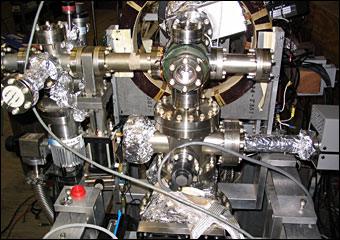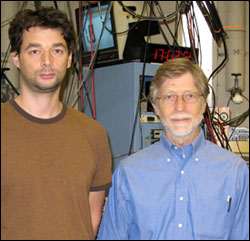
Positronium Atoms Created
RIVERSIDE, Calif., Sept. 19, 2007 -- Molecular positronium has been created for the first time in the laboratory by firing intense bursts of positrons into a thin film of porous silica (mineral quartz).
The research, by physicists at the University of California Riverside (UC Riverside), paves the way for studying multipositronium interactions -- useful for generating coherent gamma radiation -- and could one day help develop fusion power generation as well as directed energy weapons such as gamma-ray lasers. It could also help explain how the observable universe ended up with so much more matter than “antimatter," the university said in a statement.

The ultrahigh vacuum target chamber where the intense positron pulse is implanted into the porous silica film. The magnet coils carry a current of 1000 amps for a few hundred milliseconds to generate the strong magnetic field needed to compress the positron beam. (Photo courtesy D. Cassidy, University of California Riverside)
Briefly stable, each molecule is made up of a pair of electrons and a pair of their antiparticles, called positrons. Upon slowing down in silica, the positrons were captured by ordinary electrons to form positronium atoms.
Positronium atoms are by nature extremely short-lived. But those positronium atoms that stuck to the internal pore surfaces of silica -- the way dirt particles might cling to the inside surface of the holes in a sponge -- lived long enough to interact with one another to form molecules of positronium, the physicists found.
“Silica acts in effect like a useful cage, trapping positronium atoms,” said David Cassidy, the lead author of the research paper, published in the journal Nature, and an assistant researcher working in the laboratory of Allen Mills, a professor of physics, the research paper’s coauthor. “This is the first step in our experiments. What we hope to achieve next is to get many more of the positronium atoms to interact simultaneously with one another -- not just two positronium atoms at a time.”

David Cassidy (left), an assistant researcher working with Allen Mills (right), a professor of physics at UCR (Photo courtesy D. Cassidy, University of California Riverside)
When an electron meets a positron, their mutual annihilation may ensue; or positronium, a briefly stable, hydrogen-like atom, may be formed. The stability of a positronium atom is threatened again when the atom collides with another positronium atom. Such a collision of two positronium atoms can result in their annihilation, accompanied by the production of a powerful and energetic type of electromagnetic radiation called gamma radiation, or the creation of a molecule of positronium, the kind Cassidy and Mills observed in their lab.
“Their research is giving us new ways to understand matter and antimatter,” said Clifford M. Surko, a professor of physics at UC San Diego, who was not involved in the research. “It also provides novel techniques to create even larger collections of antimatter that will likely lead to new science and, potentially, to important new technologies.”
Matter, the “stuff” that every known object is made of, and antimatter cannot co-exist close to each other for more than a very small measure of time, because they annihilate each other to release enormous amounts of energy in the form of gamma radiation. The apparent asymmetry of matter and antimatter in the visible universe is an unsolved problem in physics.
Currently, antimatter helps identify diseases with the positron emission tomography (PET) scan.
Cassidy and Mills plan to work next on using a more intense positron source to generate a “Bose-Einstein condensate” of positronium -- a collection of positronium atoms that are in the same quantum state, allowing for more interactions and gamma radiation. According to them, such a condensate would be necessary for the development of a gamma-ray laser.
Their research was funded by the National Science Foundation.
For more information, visit: www.ucr.edu
Published: September 2007